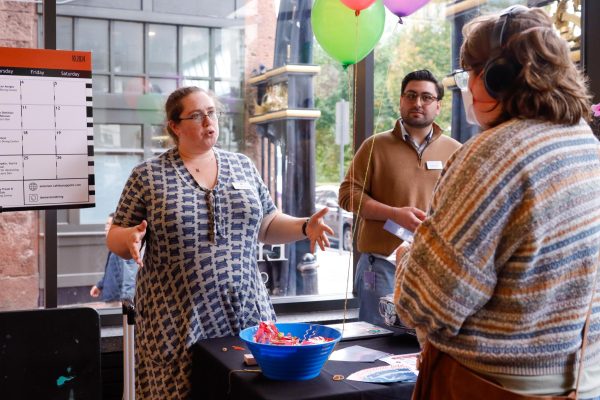As election day looms, Emerson students are looking to get more engaged. The Emerson Voter Registration Coalition (EVRC) held a voter registration drive on Oct. 1 outside of the dining hall to help register students to vote and educate them on ballot and deadline issues.
The coalition is made up of a number of staff volunteers headed by Jennifer Nival, director of Student Engagement and Leadership (SEAL), and Cate Schneiderman, School of the Arts librarian from the Iwasaki Library.┬Ā
The voter registration drive is one of several efforts by the coalition, according to Nival, who says that Emerson ŌĆ£has a history of collaborating with the organization ALL IN,ŌĆØ a nationwide democracy initiative with a goal of increasing voter engagement among college students. Efforts have ramped up in this election year, and the coalition has made it their mission to communicate the various voting deadlines to Emerson students.
Emerson participates in the National Study of Learning and Voting Engagement (NSLVE), run out of Tufts University. NSLVE found that in 2022, 79.9% of Emerson students were registered to vote while only 30.2% actually voted.┬Ā
According to Schneiderman, this is not because Emerson students are lazy, but because understanding the voting process is hard, especially with mail-in balloting.
ŌĆ£A lot of students don’t know if they can vote or where they can vote,ŌĆØ Schneiderman said, which is why the coalition is holding drives and other educational campaigns throughout October.
NSLVE reported that in the 2020 presidential cycle, 76.1% of Emerson students voted, which was 15.9% higher than in 2016 and 10.1% higher than the average voter rate across participating higher education institutions. The anonymized survey pulls out international students and others who are not eligible to vote to ensure accuracy.
Schneiderman also noted that the percentage of students who voted in 2022 was just under the national average and had been higher in 2020, the last presidential election. She attributes this to the demographics of Emerson students, who tend to be civically engaged despite the difficulty that comes with voting out of state.┬Ā
Not only do many out-of-state students have difficulty applying for a ballot, but keeping track of where they are in the process can be complicated.┬Ā
Schneiderman said that ŌĆ£certain states are not very good at publicizing that they have mail-in ballots,ŌĆØ and many ŌĆ£elected officials discourage mail-in voting.ŌĆØ

For students who call other states home, mail-in is the only option.┬Ā
Callie Tapper, a junior interdisciplinary major, is voting in her home state of New York by mail-in ballot.┬Ā
ŌĆ£I’ve been meaning to vote for a long time,ŌĆØ Tapper said, ŌĆ£but kept missing the mail-in [deadline].ŌĆØ She was assured that this year her ballot had been shipped and feels informed about the candidates in this election.┬Ā
Despite this, she wishes ŌĆ£that there was more information about third-party candidatesŌĆØ available to the public, calling the two-party system a choice between the ŌĆ£lesser of two evils.ŌĆØ
Tapper gets her news from the New York Times, but is trying to branch out more. She recognizes the Democratic Party’s social media strategy this election, in which the campaign uses trends and memes to target Gen Z, but doesn’t appreciate it.
ŌĆ£Maybe that’s not the way to get young people’s votes,ŌĆØ she said. ŌĆ£I feel like we’re not stupid.ŌĆØ
Ellen, a junior visual media arts (VMA) major from Ohio, is ŌĆ£concerned [her ballot] is gonna get lost,ŌĆØ and ŌĆ£wonders if they actually count it,ŌĆØ a fear shared by many absentee student voters.┬Ā
She feels informed about the presidential candidates, and is motivated to vote mainly because of social and international issues. She wishes ŌĆ£Palestine was more thought out on the Democrat side,ŌĆØ but knows that ŌĆ£one [candidate] is definitely worse than the other.ŌĆØ┬Ā
Ben Lampert, a senior VMA major and California native, is also voting from out of state. He has already applied for his ballot and feels assured about the process. Lampert is encouraged to vote in this election for a multitude of issues, but specifically said he likes Tim Walz because ŌĆ£he seems like a fun guy.ŌĆØ┬Ā
For Emerson students who are from Boston or the surrounding areas, voting is a little less complicated.┬Ā
Bianca Cicerone, a freshman VMA major from Somerville, plans to take the train home on Nov. 5.┬Ā
ŌĆ£I’m glad I don’t have to figure out the whole mail-in process,ŌĆØ she said.┬Ā
Cicerone said she is informed about the presidential election but is particularly motivated by local issues, like SomervilleŌĆÖs mayoral election. ŌĆ£This is my first time voting, and I like that I have a say now,ŌĆØ Cicerone said.
Overall, the EVRC hopes that with the information they are providing, Emerson students will feel confident voting in this election.
ŌĆ£Your voice is needed, and this is an opportunity for it to be heard. Engage in critical conversations, participate in the democratic process, and make a difference with your vote,ŌĆØ Nival said.┬Ā
Schneiderman added, ŌĆ£If there’s anything [you] need, like photocopies or a stamp ŌĆ” you just need to come to the library.ŌĆØ